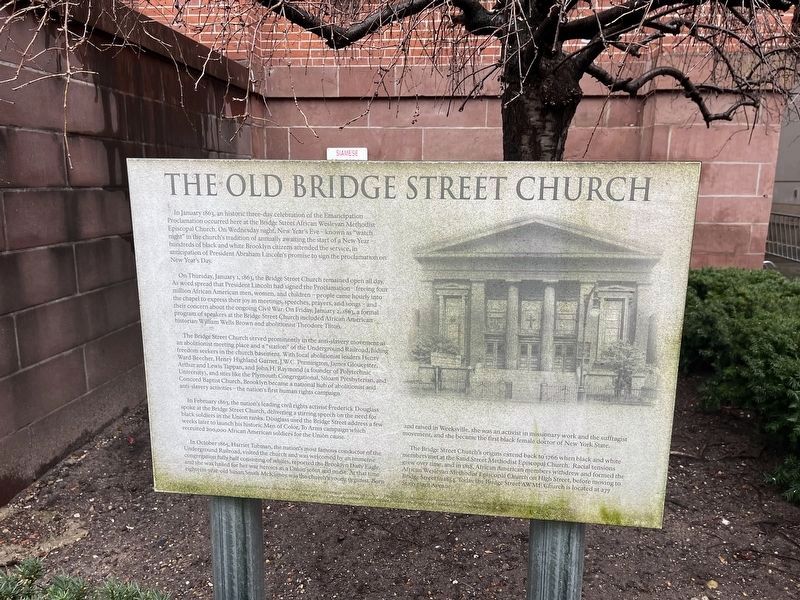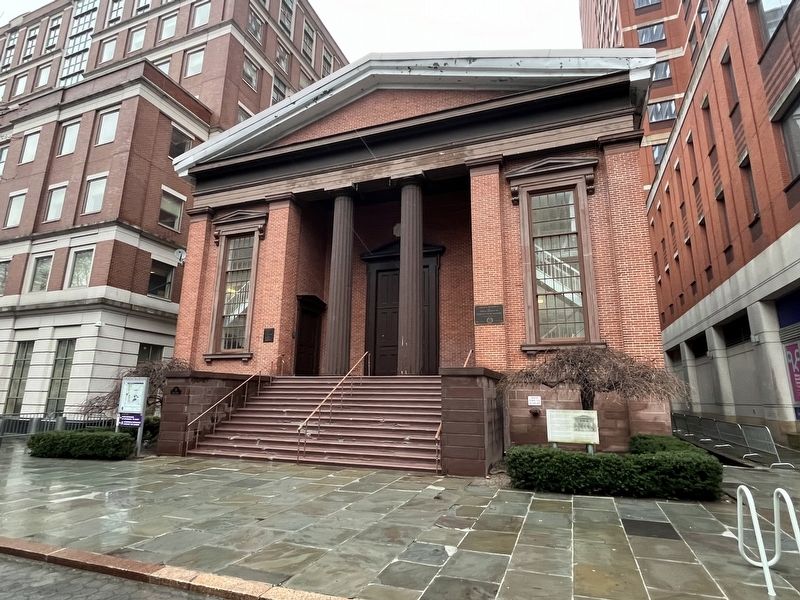Downtown Brooklyn in Kings County, New York — The American Northeast (Mid-Atlantic)
The Old Bridge Street Church
In January 1863, an historic three-day celebration of the Emancipation Proclamation occurred here at the Bridge Street African Wesleyan Methodist Episcopal Church. On Wednesday night, New Years Eve — known as "watch night" in the church's tradition of annually awaiting the start of a New Year hundreds of black and white Brooklyn citizens attended the service, in anticipation of Abraham Lincoln's promise to sign the proclamation on New Year's Day.
On Thursday, January 1, 1863, the Bridge Street Church remained open all day. As word spread that President Lincoln had signed the Proclamation — freeing four million African American men, women, and children — people came hourly into the chapel to express their joy in meetings, speeches, prayers, and songs — and their concern about the ongoing Civil War. On Friday, January 2, 1863, a formal program of speakers at the Bridge Street Church included African American historian William Wells Brown and abolitionist Theodore Tilton.
The Bridge Street Church served prominently in the anti-slavery movement as an abolitionist meeting place and a "station" of the Underground Railroad, hiding freedom seekers in the church basement. With local abolitionist leaders Henry Ward Beecher, Henry Highland Garnet, J.W.C. Pennington, James Gloucester, Arthur and Lewis Tappan, and John H. Raymond (a founder of the Polytechnic University), and sites like the Plymouth Congregational, Siloam Presbyterian, and Concord Baptist Church, Brooklyn became a national hub of abolitionist and anti-slavery activities — the nation's first human rights campaign.
In February 1863, the nation's leading civil rights activist Frederick Douglass spoke at the Bridge Street Church, delivering a stirring speech on the need for black soldiers in the Union ranks. Douglass used the Bridge Street address a few weeks later to launch his historic Men of Color, To Arms campaign which recruited 200,000 African American soldiers for the Union cause.
In October 1865, Harriet Tubman, the nation's most famous conductor of the Underground Railroad, visited the church and was welcomed by an immense congregation fully half consisting of whites, reported the Brooklyn Daily Eagle, and she was hailed for her war heroics as a Union scout and nurse. At the time eighteen-year-old Susan Smith McKinney was the church's youngest organist. Born and raised in Weeksville, she was an activist in missionary work and the suffragist movement, and she became the first black female doctor of New York State.
The Bridge Street Church's origins extend back to 1776 when black and white members met at the Sand Street Methodist Episcopal Church. Racial tensions grew over time; and
(The idea to place this plaque was born out of the vision and activist struggle of the Rev. Dr. Herbert D. Dwight, Sr. Chairman of the Downtown Brooklyn Neighborhood Alliance (DBNA)'s Center for the Study of History, Culture and Social Movements and the National Presiding Minister of the House of the Lord Churches, February 12, 2007)
Erected 2007 by Downtown Brooklyn Neighborhood Alliance's Center for the Study of History, Culture and Social Movements.
Topics and series. This historical marker is listed in these topic lists: Abolition & Underground RR • African Americans • Churches & Religion • War, US Civil. In addition, it is included in the African Methodist Episcopal (AME) Church series list. A significant historical month for this entry is January 1863.
Location. 40° 41.661′ N, 73° 59.11′ W. Marker is in Brooklyn, New York, in Kings County. It is in Downtown Brooklyn. Marker is on Bridge Street. Touch for map. Marker is at or near this postal address: 311 Bridge St, Brooklyn NY 11201, United States of America. Touch for directions.
Other nearby markers. At least 8 other markers are within walking distance of this marker. Wunsch Hall, Tandon School of Engineering (a few steps from this marker); New York University Tandon School of Engineering (about 400 feet away, measured in a direct line); Ida B. Wells (about 500 feet away); MetroTech / Downtown Brooklyn (about 700 feet away); a different marker also named MetroTech / Downtown Brooklyn (about 700 feet away); Did You Know? (approx. 0.2 miles away); a different marker also named MetroTech / Downtown Brooklyn (approx. ¼ mile away); Seeing Into Tomorrow (approx. ¼ mile away). Touch for a list and map of all markers in Brooklyn.
Credits. This page was last revised on March 12, 2024. It was originally submitted on March 12, 2024, by Devry Becker Jones of Washington, District of Columbia. This page has been viewed 62 times since then. Photos: 1, 2. submitted on March 12, 2024, by Devry Becker Jones of Washington, District of Columbia.

